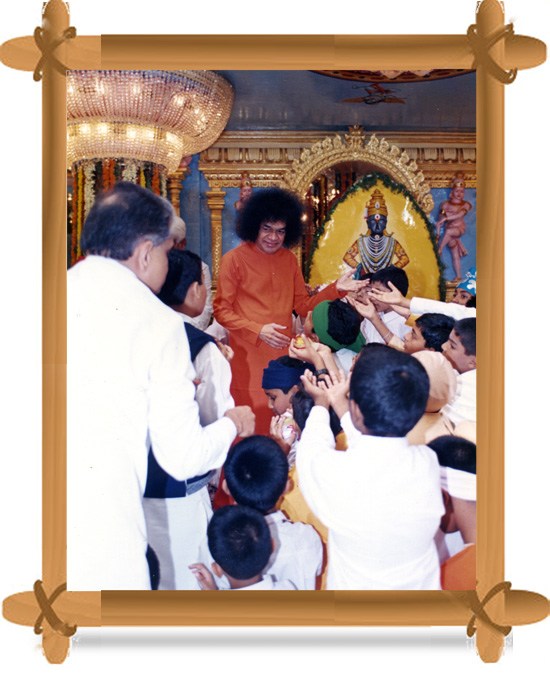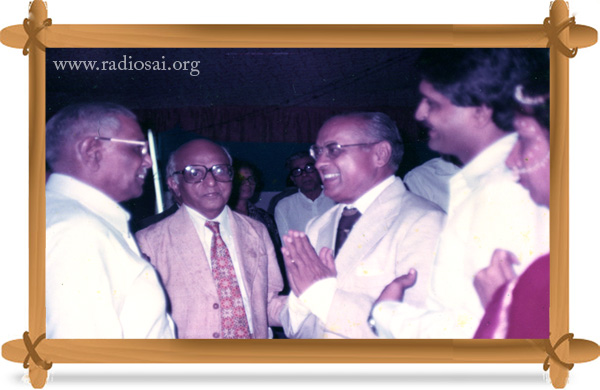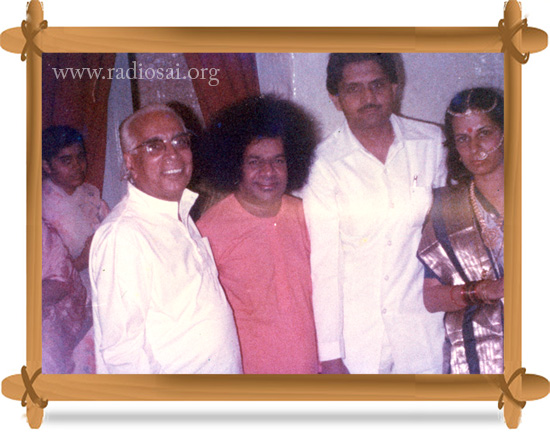|
|
| 'Like' us on Facebook | Follow us: |
Posted on: Apr 03, 2013
Law, love & life:
Learning it all from the lord
Conversation with Mr. Nimish & Mrs. Kamala Pandya
Part - 1
In this edition of Tryst with Divinity, H2H profiles two long-time devotees of Bhagawan Baba – Mrs. Kamala and Mr. Nimish Pandya. High-profile lawyers from Mumbai, India’s financial capital, both are serving Swami’s mission with dedication and humility for decades.
Mrs. Kamala Pandya (KP) is a gold medallist in Psychology from the Mumbai University. Her match with Nimish was made by Bhagawan Baba and their wedding was conducted by Baba at Puttaparthi. Following the marriage, Baba directed Kamala to pursue law studies. After graduating with a gold medal, she changed her profession from teaching to practicing law. Currently, she is an advocate in Mumbai. Kamala Pandya is also the Deputy National Coordinator of the Sri Sathya Sai Bal Vikas Education Programme in India.
Mr. Nimish Gulabrai Pandya (NP) is an advocate of the Bombay High Court and a Notary Public. He heads the law firm, Pandya & Company, Mumbai and is on the Board of several leading corporations in India. Nimish Pandya is presently the National Vice President of the Sri Sathya Sai Seva Organisation, India. He oversees the education programmes in India, including Bal Vikas and the Sri Sathya Sai Schools. A trustee of Sri Sathya Sai Trust, Maharashtra, he has directed several value-based ballets and plays for children and the youth that were performed in the Divine Presence, especially during the festival of Aashaadhi Ekadasi.
Both Mrs. and Mr. Pandya have shared a rich association with the Education in Human Values Programme since its inception.
Following are select excerpts from a conversation with Radio Sai's Karuna Munshi (KM)
KM: Sai Ram, Mr. Nimish Pandya and Smt. Kamala Pandya. Thank you for joining us. Up first, your journey with Swami – who was drawn to Him first between the two of you?
KP: Myself.
 |
 |
 |
 |
 |
 |
 |
 |
| Mr. Nimish and Mrs. Kamala Pandya offering pranams to Bhagawan during His visit to Mumbai in Nov 2009 | |||||||
I was perhaps four years old when I first came to Puttaparthi in 1959. My family was at Bangalore back then. Somebody had told my father, “There is a divine person in Puttaparthi, why don’t you go meet him?” Highly spiritual, my father needed little encouragement and within no time we all arrived at Parthi. We stayed in a small room at East Prasanthi, which almost seemed like a garage then.
KM: Parthi was so different then?
KP: Yes, it was. We would all sit at the portico and Swami would come out of the door and call families in for an interview. We were extremely fortunate to be called in as well during that first visit.
KM: Do you have any vivid memories of that meeting?
KP: I remember the interview room and Swami materialising vibhuthi, lifting His sleeve to show there was nothing hidden there. I also remember going right below His arm to get a better look at what He was doing! When I did that, Swami looked at my mom and told her she was a true mother and would be a mother again. I don’t recall any other detail.
KM: How did that first visit transform your lives?
 |
 |
 |
 |
|
 |
 |
 |
Drawn Closer to Baba Following the Lighthouse of 'Bal Vikas'
KP: Following that visit, there was a lull in my spiritual life. Then at the age of 17, Swami started appearing regularly in my dreams. Almost every Wednesday night or Thursday morning, I would be literally bombarded with His dreams that were almost clairvoyant as they indicated the shape of things to come. For instance, Swami would repeatedly say ‘teach children, teach children, teach children’. And, I would wonder where and how I should do that.
KM: Is that how you became a Bal Vikas teacher at an early age of 17?
KP: I had just finished my BA then and was looking for a job. I was in no way connected to the education field and here Swami would visit me in my dreams to say ‘teach children’. Providentially, I attended a bhajan and met a British-Guyanese lady. She was seated next to me and as soon as the bhajan got over, she said, “Would you like to come and teach children?” I was taken aback as it seemed almost as if she was repeating Swami’s words. She said she conducts classes every Thursday for children at a place that was quite close to where I lived in Mumbai. Around this time, I got a job in a school as a substitute teacher. I was fortunate that I was taken on without a B.Ed. degree as my academic qualifications were very good.
I decided I could go over after school hours and teach the children at her place. So, for a few weeks, I watched her take classes until I felt I could conduct them myself. I had to take a qualifying exam that is mandatory for all Bal Vikas gurus. I believe the lady who examined my paper called up this British-Guyanese lady to ask who Kamala was! She was impressed by my answers I think. I still remember the first story that I narrated as a Bal Vikas teacher – it was about Pundalika and I used charts to illustrate the story.
KM: There was no stopping for you after that?
 |
 |
 |
 |
 |
 |
 |
 |
Bhagawan distributing prasadam to the Bal Vikas children after an Aashadi Ekadashi Programme. Mr. Pandya can be seen carrying the box for Him |
|||||||
KP: I didn’t have a need to as Swami has been guiding me ever since.
KM: Brother Nimish, could you share with us how you got drawn to the Sai movement?
NP: I think my story continues from where Kamala joined the movement. It so happened that I used to live in the same complex where the Bal Vikas classes were held. My youngest brother Dharmesh attended those classes. You could say my family got drawn to the Sai movement through the Bal Vikas classes.
KM: Is that how you met?
NP: We were from the same college although we didn’t know each other at that time. We did know of Kamala as the Bal Vikas teacher and we would be even more surprised when my brother would come home after each class and regale us with stories and slokas. My mother eventually grew more and more interested in the Sai movement. And being very close to her, my interest was also sparked.
KM: Do you think you already had a spiritual bone in you even as a young boy?
NP: It’s funny you ask this question. I remember a humorous story from my student days at Don Bosco in Mumbai. I would always score full marks in Moral Science and not perform as well in the other subjects.
My uncles almost dismissed me as a good-for-nothing child. In my defence, I would only say that if I did that well in Moral Science, spirituality had already taken root within me even at that young and impressionable age.
KM: Which explains your pull towards the Sai movement…?
NP: Yes, and it only grew from there. I would escort my mother to Puttaparthi without really getting involved too deeply but remaining pleasantly associated with the Sai conviction. I enjoyed the bhajans and all of the activities, but never really participated in them. Of course, the turning point had to come. And, that happened when Mr. Indulal Shah suddenly invited me to his bungalow one day.
KM: Interesting, and what would the purpose have been?
NP: At that time, Mr. Pandurang Dikshit was the State President of Maharashtra. Every year, the Mumbai chapter would stage a Hindi play at Puttaparthi. Not finding anyone who could teach the characters proper Hindi, this British-Guyanese lady recommended my name to Pandurang Dikshit saying I could offer great help with my proficiency in the language and love for dramatics. The rehearsals were being held at the residence of Mr. Indulal Shah – the reason I was asked to come over.
 |
|
Bhagawan with Bal Vikas children after an Aashadi presentation |
KM: So you got initiated into the Sai consciousness in a subtle way?
NP: You could say that. I got to direct this first play called “Dekhiye Sai Ke Leela” which was scheduled to be performed in the Poornachandra Auditorium in 1979.
KM: Since then you have directed innumerable plays over the decades, haven’t you?
NP: That was one of my first plays that I directed as part of the Sai movement. It was a privilege to work with a talented person like Mr. Pandurang Dikshit who is a great artist, director, and music director. I also got to know Mr. Indulal Shah who the world held in high respect and awe. I found him to be an extremely amiable personality. Not many were aware of his love for theatre or about his competency as a director with incredible knowledge about art, acting and music.
So, we made a fantastic threesome. The fact that two of them were quite older to me didn’t make a difference and we were able to create that beautiful synergy among us.
Finding the Best and Only True Friend
KM: This might sound clichéd but at the time when Swami came into your lives, you were both academically very bright and had a great future to make it big - which you have. But, how were you able to incorporate so much of spiritual commitment, community outreach into your lives?
NP: I must share an interesting phenomenon here. As a student, I had lots of friends in Mumbai and was very popular in St Xavier’s College. Strangely, this was the point that Swami brought up during my first interview with Him. He actually chided me about the number of friends I had.
KM: Which year was this?
NP: Sometime in 1980 in Whitefield. During that visit, I remember my mother and I had to go through a tough time to reach Whitefield. We initially thought Swami was in Puttaparthi. We braved a bus strike in Kothacheruvu and walked through the paddy fields to reach Puttaparthi. But when we arrived, we realised Swami was not there. So, we rushed to Whitefield and got called for an interview the moment we arrived.
KM: How did your first interaction go?
NP: The instant Swami shut the interview door, I got fired left, right and centre on the number of friends I had. He also made a very pertinent remark. He said there is only one friend and that is God and pointed to Himself. When I look back at that juncture of my life, I realise I was so much in awe of Swami’s words that I immediately dissociated myself from all my friends. From then on, it was only Swami that I was able to connect with. For me, Swami became my only friend.
 |
 |
 |
 |
 |
 |
 |
 |
Swami with the Pandya family during a visit to their home in Colaba, Mumbai |
|||||||
Going back to your earlier question about how we were able to integrate so much of community outreach into our lives, I think it all happened because of this extraordinary relationship we shared with Swami.
KM: What impressions stayed with you about Swami?
NP: One, that I could be free of all dogmas. Swami’s explanation that God is within us and not around us freed me from the fact that I had to look for God anywhere outside. Second, Swami has said, “I am everywhere in every person and therefore share a bond with everyone”. As a young man, this posed a challenge to me. If the first sentence is true then the second must be true and that at point of time I didn’t realise that when he said there is only friend God inside. I thought he was pointing to him. So I was attracted to the physical form.
KM: Was your relationship with this ‘Supreme Friend’ all hunky dory?
NP: You would know that in all devotees’ lives, there comes a point when Swami steps back and stops talking to you. I was no exception. But when it happened, I couldn’t deal with it. It seemed like a breach of friendship. How could my only ‘friend’ behave like this, I would ask myself.
KM: It must have needed much introspection to understand what was going on then.
NP: When He kept away from me during those three – four years, I realised Swami was driving home the point that God is within me and the journey must begin from that point, from inside. It was around this period that the programme of Education in Human Values took off.
KM: How did your involvement come about?
 |
|
| Mr. Joga Rao and Mr. Indulal Shah being welcomed by Mr. G A Pandya and the couple at their wedding reception in Mumbai on 18 June 1983 |
NP: I would credit that to Professor Gokak and Indu bhai (Mr. Indulal Shah) who gave me insight that leading a meaningful life is not about living alone for yourself. They said it requires us to be associated with a noble act where we are able to give something back to the society. I think that was the seed that Swami sowed in my mind at that point of time, which impressed me. It also helped that the idea resonated with what my mother would tell me how as a child I would always be eager to help others. If somebody had to be dropped at the station, I’d always volunteer to drive them there. If something had to be brought for someone, I would take the responsibility without having to be told.
So, lending a helping hand was second nature to me – which I could tap into for the benefit of the Human Values programme.
NP: Needless to say, Swami ignited the conviction in a huge way when I met Him. He helped me take that step forward.
KM: What about you, Sister Kamala? After you became a Bal Vikas guru, didn’t you have your own ambitions, goals? You became so involved in teaching other people’s children, there was no monetary benefit, there was no great prospect of a promotion and here you were, going out of your way teaching children just because Swami had told you to do so in a dream. To someone from the outside, that doesn’t sound like a rational life decision for a bright young person. Why did you do it?
KP: For me, everything was Swami, Swami and only Swami – nothing else mattered. I wanted to do whatever Swami wanted. Earning money was secondary even though my family was going through a financial crisis then. My brother and I were supporting the entire family on our modest salary of 600 rupees and some tuition money. Regardless, nothing seemed more important than being in the service of Swami. He just didn’t allow us to feel that we were in any sort of crisis. We were very happy and lived a rich life. For us, Swami was everything.
KM: How often were you able to meet Swami during that phase in your life?
KP: Swami used to visit Mumbai every May, December or January. Those months would give us an opportunity to recharge. He would come, talk to me or ask me something. From somewhere in the crowd He would find me and that was enough to help me tide over the next few months until His next visit.
 |
|
After the wedding in the Interview Room in Prasanthi Nilayam. Mr. Arjandas Bharwani (Kamala's father) and the newly wedded couple with Swami |
KM: You would visit Prasanthi too?
KP: I would try and attend any workshop on Bal Vikas or Education in Human Values. The moment I’d reach Prasanthi, Swami would look for me and ask, “Kabhi Aya? Kiske saath aya? Husband laya? Mother-in-law aya?” (When did you come, who did you come with, did you bring your husband, did your mother-in-law come?) The bonding was so intense that nothing else mattered.
The Match is Made But a Divine Play Follows
KM: Yours is a match made in heaven as Swami literally played your matchmaker and performed your wedding.
KP: To such an extent that Swami kept telling me that He would give me this boy, but to him, He would say, ‘No, not this girl’.
KM: Swami played the prankster with you?
NP: Yes, He sustained this fun for almost a year. Narad muni in full form!
KM: Tell us more, we are curious now!
NP: As you know, Swami was a dramatist nonpareil. Even with our marriage, He had to do something interesting. It all started with this huge event in Mumbai in Shivaji Park where for the first time we had the convocation of the pre-seva dal children. Sri Bal Thackeray, the late Shiv Sena Supremo, was the chief guest. Kamala was the master of ceremonies, while I was in-charge of cultural affairs. True enough, the articulate speaker that she is, Kamala spoke very well. Somewhere in the midst of all this, Swami must have caught my admiration for her talk that day. From that point, He took charge to build the relationship between us. That day in the evening, when Swami returned to Dharmakshetra, I was awarded the privilege of giving Him a flower before the Arathi. When I picked up the flower and handed it to Him, He threw it back at me.
NP: He said, “Wife ko do” (give it to wife). I was shell-shocked because I was going through a phase when I had decided to remain celibate and stay away from anything remotely connected to relationships. So, imagine my utter surprise when Swami asked me to give the flower to my ‘wife’! I looked at Him extremely puzzled. He kept saying, “Wife ko do, wife ko do” (give it to your wife). From then on, He would frequently ask my mother, “Oh! tumhara daughter-in-law kider hai? Bal Vikas guru hai?” (Where is your daughter-in-law, she is a bal vikas teacher). My mother would not know who or what He was talking about. He then told her about Kamala and helped us get to know each other. But after a while, Swami completely changed track and went on reverse gear. He would tell my mother not to consider Kamala as she is Sindhi by birth while we are Gujarati. Of course, He always wanted us to ultimately get married. His antics were His way of preparing both the families for the union.
KM: Giving you all time to get used to the eventuality?
NP: Yes, Swami would approach my mother and say, “Look she is a Sindhi, in a sense she is Pakistani, so don’t do it”. And, He would go back and tell Kamala, “Don’t worry, it is the same boy you will get married to”. This drama went on for one and half years and we were all thoroughly confused by the end of it all.
 |
|
Swami shows the way….at Dharmakshetra, Mumbai |
KP: Not only that, Swami would talk to me in the lines. Once, He called me out of the line and said, “Bombay Bal Vikas (that was His name for me)! Come here”. After almost 7-8 steps, He said “Paadanamaskar lelo” (take padnamaskar). After I did that, He asked me not to listen to anybody else, and said His word is the first truth. Just a day before, He had called his family for an interview saying I was not the girl for their son and He would bring another girl for him!
KM: I can understand how thoroughly confused all of you would have been.
NP: Absolutely confused. At least she was. I was confident that Swami was pulling my leg because I did not see any other purpose to this drama that was happening. And, at the end of the day, it takes one dramatist to understand the other dramatist.
KM: So, how was it all put together?
NP: Dr. Fanibunda came home after he returned from Whitefield and said Swami has asked us to visit Him. We rushed to Puttaparthi, Swami fixed a date and the wedding happened as He ordained.
KM: In the interview room?
NP: Yes, in the interview room.
KP: Swami had asked me in Mumbai about where I would like the marriage. He said, “Do you want a big public show or do you want Swami?” Of course I said, “Swami I only want you I don’t want anything else. Even a small room would do.” He replied, “Interview room mein karthe hai, dus meri log, dus thumhare and dus husband ke log bulathe” (I'll do it in the interview room. There'll be ten of my people, ten from your side and another ten from your husband's side of the family). However, there were more than 30 people at the wedding because He must have invited more.
NP: And he was more excited than us about our marriage. He had asked us to assemble at eight in the morning, but He was already there one hour earlier.
Not only that, He also demanded to know from the others why we had not yet shown up yet. So we almost ran half-dressed. Before we knew what was going on, we were in the interview room and the marriage was over!
KM: Swami performed the ceremony?
KP: He took care of everything. Just as He had told me in my dream (when I was at Whitefield for a Bal Vikas workshop) that He would be the purohit at my wedding, Swami lived up to that word. At that time, my knowledge of Sanskrit and Hindi was so weak that I didn’t understand the meaning of the word ‘purohit’ until my friend explained that it meant ‘supreme priest’. To me, the supreme priest could only be God, meaning Swami. From that dream onwards, Swami kept coming back to me with His words, “I will perform your marriage, I will perform your marriage”.








